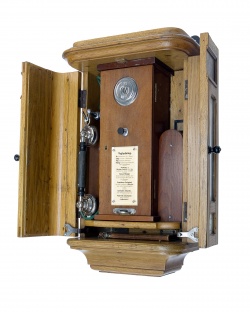Now the 10-ore [Penny] Dropped
01. Nov. 2005

One of Kjøbenhavns Telefon-Automater Ltd.'s public telephones, model 1898, in a later version without winding handle.
Technical Jargon
It is a fine, little wooden wall cabinet. TELEPHONE it says above the two doors which give access to the apparatus, a coin box and a shelf for the tele-phone directory. First you had to call the exchange. When the operator said "Ready", you would throw your 10-ore into the coin box. When the operator had registered the proper sound of the insertion, you would be redirected to the requested sub-scriber.
Popular humour in Copenhagen soon made the drop of the 10-ore synonymous with perception. So "Now the 10-ore dropped" became an expression meaning that somebody suddenly realizes some-thing. Today the phrase is drastically on the decline, like the slot telephones themselves. The mobile phones have almost killed them, but only 10 years ago we still found them everywhere: The slot tele-phone - the payphone - the public call box. A dear child with many names, and dear it was indeed for most of a century. However, the birth of it was not easy.
Promising Business
In 1897 travelling director Sophus Ritter brought home a good idea from abroad. Slot telephones - in cafés and restaurants, shops, banks, and in public buildings - and in the stairways of urban tenement houses where only few people had their own telephone.
He invited to founding of the limited company Kjøbenhavns Telefon-Automater [Copenhagen Slot Telephones] on 7th February 1898.
The first automat was put up on 17th December 1898 in the National Bank and before the end of 1899 400 apparatuses had been mounted all over town. In a report of 6th December 1902 the company writes: "In order that the public may easily find the telephones, a small projecting sign has been placed on the façade of the house consisting of a blue plate under a white porcelain insulator and above this a conspicuous, red, horseshoe-shaped sign has been placed this year". But the dividend for the shareholders was long in coming.
Burglary Epidemics
After four years of deficit it is ascertained that people are simply not telephoning enough from the slot telephones (in average twice a day per apparatus). They are only accessible during daytime as they are protected behind doors which are locked after office hours and in tenement houses after 10 p.m. when the front door has to be locked according to police regulations. Frequent "customers" do exist, however: 155 burglaries during the first four years of operation.
Keen Competition
The price of a slot telephone conversation, 10 ore for three minutes, must also have meant a hin-drance of immediate success, because 10 ore in 1898 is equal to about 6 kroner in today's currency. In 1898 a letter could be sent by mail for delivery in Copenhagen on the same day at the price of 4 ore only. If it had to go faster, one of the many messengers of the town could be sent out on a bicycle at the cost of a few ore - and bring back a reply. By the way, one of these messenger services belonged under the new telephone kiosks which had adorned the squares of the city since 1896. And from here it was soon possible to telephone anytime day and night. Payment took place to the kiosk lady and not by inserting a coin.
With the always illuminated green iron call box with frosted-glass windows that KTAS put up in 1935, the situation changed appreciably. Not until then did a slot telephone become synonymous with the "telephone box"; the one which would establish itself throughout the whole country. There was access to it around the clock and the price was still only 10 ore. It became an immediate success - also eco-nomically. On 1st January 1940 KTAS took over the operations of the limited company Kjøbenhavns Telefon-Automater. At that time the 10-ore had dropped.
This article may be copied or quoted with MuseumsPosten, Post & Tele Museum as source.
Comment this article
Only serious and factual comments will be published.